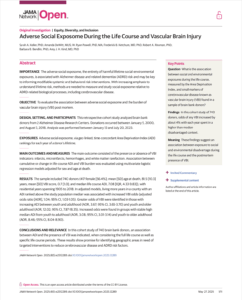Using a novel residential history method developed at CHDR, the study found that odds of any vascular brain injury increased by 4% with each year participants spent in a disadvantaged neighborhood, as measured by the Area Deprivation Index (ADI).
The UW School of Medicine and Public Health’s Center for Health Disparities Research (CHDR) is pleased to share the publication of groundbreaking new research conducted by members of our team. The very first of its kind, this study forges a path toward understanding the impact of the social exposome—which encompasses cumulative social and environmental exposures, including structural inequities like systemic racism—on biological processes, disease, and health outcomes across an individual’s lifespan.

Led by CHDR Research Scientist Dr. Sarah Keller, “Adverse Social Exposome Over the Life Course and Vascular Brain Injury” measured geo-linked, time-concordant Area Deprivation Index (ADI) rankings and the presence or absence of vascular brain injury (VBI) in 740 brain bank donors from two Alzheimer’s Disease Research Centers (ADRC).
Using a novel residential history method developed at CHDR, Keller et al. found an estimated 4% increase in the odds of VBI for each year spent in a neighborhood with an ADI greater than the population median.
“In this cohort study of 740 brain bank donors, an association between ADI and the presence of VBI was indicated, when considering the full life course as well as specific life course periods. These results show promise for identifying geographic areas in need of targeted interventions to reduce cerebrovascular disease and ADRD risk factors.”
The authors also noted an association between increased odds of VBI and high ADI across life periods, as well as increases in ADI from youth to adulthood to older adulthood. These findings reiterate the importance of research that assesses the social exposome’s influence on health outcomes and inequities, not just at a single point in time but throughout the life course.

Notably, this study is the first to retrospectively link cumulative social exposome data to brain tissue from ADRC brain bank donors. Whereas most previous efforts to measure the social exposome have done so through studies that rely on a single assessment in time, Keller et al. created ADI rankings for each year of each brain bank donor’s life in order to accurately capture the cumulative social exposome of over 700 donors. For this reason, their research has been lauded as a groundbreaking step in investigating how the particular timing and accumulation of adverse social exposome exposure may contribute to disease.